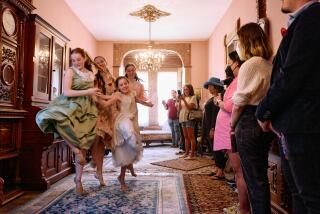In ‘Books,’ Charlip Expresses Himself
- Share via
Remy Charlip’s biography lists achievements as modern dancer, choreographer, stage director, set designer, plus a separate career as children’s book author and illustrator.
A sense of serious whimsy links many of these pursuits and it loomed large on Sunday in the San Francisco-based Charlip’s retrospective program “Books Into Theater, Theater Into Books” at the Mark Taper Auditorium of the L.A. Central Library downtown.
Born in 1929, Charlip danced for Postmodern precursor Merce Cunningham in the 1950s. But his own choreography has often included as many facial expressions as steps because, as he explained Sunday, “with Merce, we never used our faces.”
The suite “Seven Short Songs” emphasized wry gestural commentary, artful body-sculpture and bittersweet reminiscences, with Charlip adapting Irving Berlin’s “It Only Happens When I Dance With You” to express his need to love and accept himself.
First danced in 1966, his mercurial “Meditation” solo (to Massenet) displayed his mastery of pantomime, with forceful gestures melting into passive anguish and accusatory finger-pointing yielding to fearful trembling. However, upward reaching dominated the piece; Charlip is not someone who stays hopeless for long.
A videotape of Toby Armour in “Dance in a Bed” provided a sampling of Charlip’s innovative “Air Mail Dances,” for which he would draw a series of positions, mailing them to the performer. That performer would then complete the dance by creating transitions between the positions.
Shot from above, and using the same Saint-Saens score familiar from “The Dying Swan,” Armour’s version featured restless stretches, twists and splits: everyone’s nighttime tossing and turning heightened and refined into a dance with plenty of movement but no steps.
Charlip appeared amid giant household objects in a videotape of “Glow Worm,” acting out the song lyrics and his memories of childhood in sign language but periodically letting the movement carry him into darker emotions.
Slides of Charlip’s picture books, and a discussion of how these works turned into stage vehicles for his children’s theater group, the Paper Bag Players (started in the late ‘50s in New York), completed a presentation rich in insight, feeling and high proficiency.
More to Read
The biggest entertainment stories
Get our big stories about Hollywood, film, television, music, arts, culture and more right in your inbox as soon as they publish.
You may occasionally receive promotional content from the Los Angeles Times.










